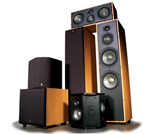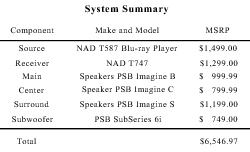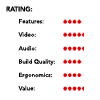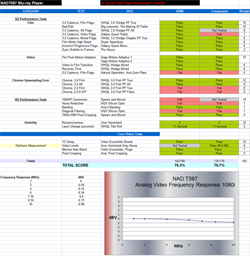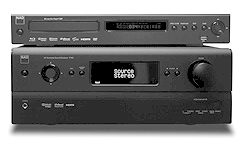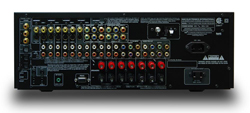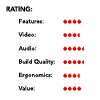Introduction
Welcome to the inaugural Secrets of Home Theater and High Fidelity system review! We are planning to publish a series of similar reviews to highlight system packages in the Low (up to $2,500 MSRP), Medium ($2,501 – $5,000 MSRP) and High (over $5,000 MSRP) price categories. The systems will all include a source component, receiver (or prepro and amp), speakers and sub (optional). We will also evaluate products in the burgeoning soundbar category. We will strive to select balanced systems that will offer the best value in their respective price ranges. These reviews will be focused on helping readers select turnkey systems for new installations or upgrades.
This is a new initiative and we are open to any feedback you want to offer. You can do so by posting comments to this review. Better yet, join us at the CAVE and post your thoughts on the Really Affordable System Forum.
We are working for you and your feedback will help us focus on meeting your needs.
System Description
The system under review here is composed of a Blu-ray player, an A/V receiver, five satellite speakers and a subwoofer. The electronics come courtesy of NAD and the speakers are PSB. Both of these product lines are marketed and distributed under the banner of the Canadian-based Lenbrook Group. These products are not commonly discounted, so the projected system price comes in at a shade under $6,550. This places the system just over the threshold we’ve established for “High Priced” systems which we have defined as systems with a street price over $5,000.
The system includes small bookshelf speakers on all four corners, an MTM center speaker, a 12″ powered sub, a Profile 2.0 Blu-ray player and a modestly powered surround sound receiver. The receiver can decode all the latest surround formats. The speakers and subwoofer are eminently competent. All the components feature classy styling and solid build quality.
Price Range: High (over $5,000 MSRP)
- System MSRP: $6,546.97
- System Street Price: ~ $6,546.97
System Rating:

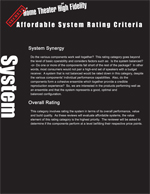
Specifications : NAD T587 Blu-ray Player
- Design: Profile 2.0 Blu-ray Disc Player (BD Live with User-supplied Memory Stick)
- Supported Formats: Blu-ray Discs (BD), BD-R/RE, DiVX, MP3, WMA, Photo Files, DVD Video, DVD±R, DVD±RW, Audio CD, CD-R/-RW, AVCHD
- Supported Audio: Linear PCM (uncompressed) via HDMI, Dolby TrueHD, DTS HD/MA, Dolby Digital and Dolby Digital Plus (via HDMI, Optical or Coax), DTS (via HDMI, Optical or Coax), Analog 2 channel downmix
- Supported Video Resolutions: Up to 1080p/24 over HDMI, upscales DVD to 1080p over HDMI, and up to 1080i over component
- Dimensions: 2.4″ H x 17.1″ W x 11″ D
- Weight: 7.7 Pounds
- MSRP: $1,499 USA
- NAD Electronics
Introduction
The NAD T587 represents NAD’s first foray into the Blu-ray arena. NAD started big by building the T587 to the Blu-ray Profile 2.0 spec. The T587 can also handle CD and DVD discs among other formats such as DiVX. It is not a universal player and will not spin DVD Audio or SACD discs. Its circuitry is based on the Broadcom decoder. A nice touch is that the player comes with auxiliary feet that closely resemble Vibrapods. (Click on the rating box to enlarge it.)
The T587 has a fairly typical suite of inputs and outputs with HDMI, component video, composite video, two-channel analog audio, LAN, coax and optical digital outs. There are no multi-channel analog audio outs. The T587 does sport a front USB input where the user can attach a jump drive or an MP3 player.
Typical, too, for an NAD product is its understated styling and solid build quality. NAD bills the T587 as having fast load times and I can attest that it was among the fastest stand-alone players I have used. Besides a minor glitch when I first powered on the T587, it never hung up or died during the whole review period and I watched scores of Blu-rays and DVDs.
The T587’s remote is a somewhat rudimentary control interface that is not backlit. It’s essentially the exact same remote that comes with the NAD T747 receiver. I had to look at them both for a few seconds before I could identify any obvious differences. The most obvious difference is that the receiver’s remote has a volume up/down button, but the two remotes are easy to confuse. This wasn’t a big issue as the receiver’s remote was a “universal” design which could be programmed to control other NAD products. I wound up using the receiver’s remote 99% of the time while the T587’s remote stayed in the cabinet waiting on deck to be called up if I wanted to tweak the output resolution or audio output mode. All in all, the remote is solid and easy to use in the dark courtesy of the varying button sizes and shapes, the logical button layout and generous button spacing. The T587 boasts a responsive and slick menu system that loads quickly.
In Use
I’m not sure if this player loads faster than a Sony PS3, but if it doesn’t, then any differences in load times are basically insignificant. That’s high praise, indeed. To be fair, the NAD T587 hung up the first time I turned it on. After rebooting it, I never experienced a single glitch in screening scores of movies. That’s high praise, too. I had hopes that the player’s USB input would be a decent iPod control interface, but it was not. No cover art or track names were displayed. So you will need to invest in the optional NAD iPod dock if you want to get the most out of your iPod experience with the NAD system.
The images produced by the T587 Blu-ray player looked about like any other player when viewed on my 50″ Pioneer Kuro monitor at a seating distance of about 9′. On the other hand, I have never seen my Panasonic LCD front projector look better when fed a 1080p/24 Hz signal from the T587. (I have a 1.1 gain 100″ diagonal 16:9 screen that is also about 9′ from the main seating position.)
One thing that made this player’s picture so good was its ability to render the finest details. This detail was rarely etched or enhanced looking. It was generally smooth and natural in appearance. A good example of this was the exemplary texture and detail I saw in the Doubt Blu-ray. You could see this detail in the bricks on the front of the church during the opening credits. This disc is packed with video and audio nuances that were delicately communicated by the T587. I particularly liked the color reproduction I saw. There is a scene also near the beginning of the film where a group of kids are lined up in front of the school. One of the girls is wearing a red jacket. This was a highly saturated red which looked realistic through the T587. Elsewhere, Doubt didn’t test the color gamut very much but the colors (such as skin tones) were natural and convincing. The motion of the falling leaves and snow was extremely smooth and free of judder. This is a very compelling film about a disturbing subject matter and the T587 really brought me into the experience.
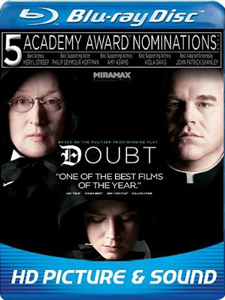
Australia is a bold production that’s a little pretentious. The movie is filled with lots of bright scenes of the savanna. These scenes came through to the screen brilliantly. This was the best I have seen my projector look. The detail in the image was once again smooth and detailed. The motion was amazingly smooth as well. The shadow detail and the layering of grays were generally very good in the night scenes. I may be a little naïve, but I was genuinely surprised when Nicole Kidman and Hugh Jackman “hooked up” in this story. In their first kiss scene, the deep blacks crushed. I’m not sure why this happened. It could have been the PJ, it could have been the receiver or it could have been the T587. I didn’t experience this problem with any other films through this system.

On The Curious Case of Benjamin Button, the picture was a little soft throughout and the colors were muted. Some of this may be due to the heavy CGI effects in this movie. I didn’t see this film in the theaters so I am going to assume that this was a style choice by the director to elicit a melancholy mood from the audience.
I found the picture and sound on Taken to have fine impact all around. No hype, just a clean picture and sound. The picture was punchy and sharp on The International… it really blew me away. I was concerned that the punchy and sharp picture may have gone a little too far on Frozen River which looked like video to me. Then I checked into it and guess what? Frozen River was shot on video. My bad.
The T587 struggled with concert videos that were shot at 30 frames per second versus 60 fields per second. This is a common issue with many deinterlacing solutions. When I set the NAD T587 player and the NAD T747 receiver to 1080i output and passed the signal to my Pioneer display, then the picture fell into place nicely. I did wonder what a casual user would do or think about all the video artifacts that otherwise ensued.
Do you have a library of standard DVD’s? Well then you can rest assured that the T587 will do a fine job up-converting them. At 1080p/24, the DVD of Monsters, Inc. really popped off the screen. It was a near HD-like performance. Subjectively, it seemed as if the T587 was able to correctly reconstruct the 24 fps cadence as I didn’t see any obvious motion issues with the picture. Other DVD’s didn’t look quite as good as Monsters, Inc. On other DVD’s, the T587 generally performed about on a par with my defunct HDDVD player which has always been a very solid up-converting performer.
On the Bench
Measurements were taken with our Tektronix Oscilloscope from the component analog video outputs at 1080i resolution. The player passed our tests for Y/C delay issue and the image is in alignment in regards to its luma and chroma channels. The player measured a very respectable 98.9 IRE giving it a passing score for our levels test. While the NAD T587 is able to display blacker than black content, the T587’s frequency response curve was measured to have a steady decline into the highest frequencies resulting in an image that is slightly lackluster in fine details. This player also had issues on some of our Chroma Upsampling Error tests, and it couldn’t pass our 2:2 cadence test as well as the more difficult ICP test.
In our HD section of the Benchmark, the NAD T587 had below average performance. The player failed both of our tests for proper 1080i/p conversion using 2:2 and 3:2 cadences which means that there will be some material out there that will be displayed with a loss in resolution during playback. The NAD T587 had only average image quality with slight loss of resolution in the highest frequencies of the luma and chroma channels.
The player did pass our test for image cropping so it does produce a full image without clipping any pixels. The NAD T587 passed our test for banding but didn’t do quite as well with our noise reduction tests as it doesn’t employ any kind of advanced noise reduction techniques. Another issue I found was that the T587 couldn’t properly display any of the material in our diagonal filtering tests and therefore the player will have jaggies or stair stepping on diagonal lines.
Standard DVD Performance
The NAD T857 had pretty good performance in our standard DVD deinterlacing tests passing all of our film-based high resolution detail tests, locking onto the cadences right away and holding them for the duration of the tests. On video based material, the T587 didn’t fare as well. While the T587 did pass our motion adaptive tests, it failed our diagonal filtering tests and also failed our 2:2 Cadence, film flags test with obvious jaggies in real world material. The player passed our high detail test using our Super Speedway pattern but exhibited much more difficulty in the more difficult coliseum pan over screen from Gladiator. The player couldn’t lock onto the pattern and resolution loss and moiré was evident.On the usability portion of the benchmark the NAD T587 did well, with a quick layer change clocking in at under a second and rather quick overall response during general playback.
Specifications : NAD T 747 Surround Sound Receiver
- Design: 7-Channel A/V Surround Receiver
- Codecs: Dolby TrueHD, DTS HD Master, Dolby Digital Plus, Dolby ProLogic IIx, DTS HD High Resolution Ausio, Neo:6, EARS surround, Dolby Headphone
- Power Output: 2 x 110 Watts RMS into 8 Ohms, 7 x 60 Watts RMS into 8 Ohms
- THD+N: 0.08%
- Room Correction: Proprietary with 5-band parametric EQ
- Video Processing: Faroudja DCDi
- Inputs: 4 HDMI; 3 Component Video; 4 S-Video; 4 Composite Video; 2 Optical Digital; 2 Coax Digital; 7.1-Channel Analog Audio; Front – S-Video, Composite Video, Analog Audio, Optical Digital
- Outputs: 1 HDMI; 1 Component Video; 1 S-Video; 1 Composite Video; 7.1-Channel Analog Pre-out; 1 Coax Digital; 1 Optical Digital; IR Mini Plug; 12-Volt Trigger; Zone 2: S-Video, Composite, Stereo Analog
- Dimensions: 6.6″ H x 17.1″ W x 15.5″ D
- Weight: 29.3 Pounds
- MSRP: $ 1,299 USA
- NAD Electronics
Introduction and Setup
The NAD T747 AV Surround Sound Receiver is a 7-channel two zone receiver that is capable of decoding bitstream inputs of all the latest high-resolution audio formats. I like its understated styling a la NAD. The minimalist front panel has a simple two-line VFD display in the center of the panel. The characters on this display are about 3/8″ high. This is a major improvement over the super small logos that are commonly found in so many of today’s receivers and processors. Moving from left to right across the front, there is a power switch, a headphone jack, a cursor control, menu button, listening mode button, source selection switches, a volume knob, and a set of front A/V inputs. Besides the manufacturer’s trademark and the unit’s model number, the front panel sports only 3 other logos: Dolby TrueHD, DTS HD Master Audio and HDMI. That’s it. No cluttered alphabet soup for NAD!
Around back, the T747 has a full complement of inputs and outputs; including 4 HDMI inputs, a 7.1-channel analog input, an XM radio input, IR ins and outs, an optional iPod dock input and zone 2 outputs (SD only, but with variable or fixed audio). One surprising throwback is a switched AC outlet. Interesting. The speaker outputs are solid five-way binding posts. The power amplifier outputs for the surround back channels can be assigned to provide speaker level output for Zone 2.
The remote control provides comprehensive functionality to put the user in command of all the T747’s features and operations. It is not backlit, but the buttons are reasonably well-differentiated by size and shape so it was easy to use effectively in the dark after a few days on a short learning curve. It can control other NAD components, but no codes are supplied for other manufacturers’ products. It is not a learning remote, either. I was slightly disconcerted with this particular unit as the batteries bounced around inside the remote a little. NAD includes a second, smaller remote for Zone 2 operation.
The T747 has a proprietary set-up and room correction utility. The small, grey microphone resembles the original Audessey mics and had a threaded insert so it could be easily mounted on a standard tripod pan head. The algorithm makes adjustments only at the prime seating position and includes a five-channel parametric equalizer. I’m sure a lot of readers will think it can’t be any good because it doesn’t handle a whole bunch of seating locations and have lots of equalization bands. My experience with the T747 was that it calibrated quite swiftly and I ran it one time, went back in and changed all the crossover settings to 80Hz and never messed with it again. The resulting sound was very nice. If you want to reset the T747 to factory defaults, then you will have to call technical support: the manual is very brief and does not include this information. (The manual was kind enough to provide this direction on Page 24, however, “Place the supplied microphone in the listening position at about the same height as your listening ears.” I was about to put it at the height of my listening eyes, whew!) But it is easy to re-run the set up utility if you are not happy with the results. You cannot review or manually set the EQ settings with the T747.
Setting up the inputs on the T747 took a little longer than required by most receivers. Navigating the menus is at first awkward because sometimes you use the right arrow to advance through the menu tree and sometimes you press the enter button to effect a change. It wasn’t always readily apparent which way was right way to do it each and every time. The user also must key in the input names. It bothered me that NAD didn’t have labels like DVD, Blu-ray or CD that the user could select, but it only consumed about 30 minutes of my life to enter the correct names. It took this long because the menu didn’t provide a “keyboard” interface and instead I had to scroll through all the upper and lower case letters as well as a wide range of integers and special characters to name the inputs. So you find yourself asking, “Should I scroll up or down for the fastest way to get to the lower case letters?” By the time you figure this out, you’ll be finished naming the inputs. On the plus side, once you are done, only the active inputs show up on the list: After set up, even the least experienced user in the house could get light and sound as desired.
This brings me to one other problem I had with the user interface, you couldn’t wrap around the menus so if you wanted to go to the last item on a page, you had to scroll all the way through to the end of that menu. This was particularly annoying when I wanted to switch between 60Hz and 24Hz operation. The menu location where you change that parameter is the next to last menu item in the whole tree. The T747 always processes the video inputs. There is no pass-through capability and I found myself accessing this 24/60 Hz toggle everytime I switched between satellite and Blu-ray. In practice, this was only a minor problem, though.
All in all, the T747 was a well constructed piece of equipment that had a very solid feel to it. But it was modest in its size and weight. So I didn’t need to wear a hernia belt to lift it into my equipment rack. The T747’s class AB amplifiers generally ran pretty cool so on those occasions when we forgot to turn it off at the end of the evening, I didn’t feel too bad about it because the T747 didn’t seem to have a carbon footprint a mile wide like my reference THX Ultra 2 receiver.
In Use
The T747 has the capability to store and later recall user-defined A/V presets. With these presets, the user can establish things like the surround mode, bass/treble tone controls, rear speaker delay, lip sync delay, etc. They can be assigned to individual inputs as defaults. They can also be called up on an ad hoc basis to quickly accommodate specific program material. I did not bother with these presets and never felt like I needed them. The basic set up was just perfectly fine by me throughout the entire review period.
As mentioned in the previous section, I was frustrated that you couldn’t bypass the receiver’s video processing. It generally worked pretty well with most program material (but struggled with 30 frames per second music videos). The biggest issue with the receiver’s video processing was that whenever I wanted to watch a film-based Blu-ray, I had to scroll through a bunch of menu items to toggle the receiver from 60 Hz to 24 Hz. It didn’t really take long to do this it was just a little annoying. I also felt that casual users would be lost trying to switch this setting back and forth. So I guess most people would set the receiver to output their display’s highest resolution at 60 Hz and leave it at that. NAD may consider a way to bypass the video processing in the T747 or make the 24/60 Hz selection an item that can be defined through the A/V presets.

The receiver had a very low noise floor which was especially apparent while screening a movie like Doubt with its compelling, minimalist mix. Or check out the scene near the end of The Reader where Kate Winslet says, “The dead are still dead”. The attack and decay in her voice were so real sounding and the noise floor was so low, I had chills up and down my spine. A certain purity of tone overlaid on a silent background came through on SACD’s like Eric Clapton’s classic “Slowhand”. I put on this SACD just to listen to a few tracks and I wound up listening all the way through because the performance through the NAD/PSB system was so remarkably good.

The T747 reached its power output limits if I cranked it up on material such as the attack scene in Australia. Most of the time, however, I felt that the receiver offered very good macro dynamics as in the submarine scene in The Curious Case of Benjamin Button. So it was one of those chameleon-like experiences where the program material, my mood and other factors combined to create a somewhat variable experience in terms of the perceived maximum SPL’s. Bear in mind that I have a pretty large theater space and the PSB Imagine speakers are rated at 4? nominal. I would certainly recommend the NAD T747 receiver if your space is up to about 3,000 cubic feet or so. It just may not be the right choice for a really large space like mine. The T747 typically sounded really great and put out a lot more power than one would expect based on its modest rating.

The system as a whole delivered an un-hyped, articulate sound with well developed surround envelopment.
Specifications : PSB Imagine B Bookshelf Speakers (Front Left, Right), Imagine C (Center), and Imagine S (Surrounds)
- PSB Imagine B (Main Channels)
- Design: 2-Way, Ported
- Drivers: One 1″ Titanium Dome Tweeter, One 5.25″ Woofer
- MFR: 52 Hz -23 kHz ± 3 dB
- Sensitivity: 87 dB
- Power Handling: 150 watts
- Nominal Impedance: 4 Ohms
- Crossover: 1.8 kHz
- Dimensions: 13″ H x 7.5″ W x 12″ D
- Weight: 17.2 Pounds/Each
- MSRP: $999.99/Pair USA
- PSB Speakers
- PSB Imagine C (Center)
- Design: 2-Way, Ported
- Drivers: One 1″ Titanium Dome Tweeter, Two 5.25″ Polypropylene Woofers
- MFR: 47 Hz -23 kHz ± 3 dB
- Sensitivity: 87 dB
- Power Handling: 150 watts
- Nominal Impedance: 4 Ohms
- Crossover: 1.8 kHz
- Dimensions: 7.5″ H x 20.5″ W x 13.6″ D
- Weight: 30.5 Pounds
- MSRP: $799.99 USA
- PSB Speakers
- PSB Imagine S (Surrounds)
- Design: 2-Way, Sealed Enclosure
- Drivers: Two 1″ Titanium Dome Tweeters, Two 5.25″ Polypropylene Woofers
- MFR: 65 Hz -23 kHz ± 3 dB
- Sensitivity: 87 dB
- Power Handling: 150 watts
- Nominal Impedance: 4 Ohms
- Crossover: 2 kHz
- Dimensions: 12.6″ H x 10.8″ W x 6.9″ D
- Weight: 16.3 Pounds/Each
- MSRP: $1,199.99/Pair
- PSB Speakers
Introduction
The Imagine speakers are PSB’s newest speaker line. There are four models in this line – The Imagine T towers, the Imagine B bookshelf speakers, the Imagine C center speaker and the Imagine S surround speakers. I opted to review the Imagine B’s for the mains versus the much more common towers for two reasons – first, this is the inaugural Secrets system review and the point is to review affordable system and the bookshelf speakers are somewhat less expensive than the towers and secondly, my system works better with bookshelf speakers. I have a Pioneer Kuro display and a front projector with a screen that lowers down in front of the Pioneer display. The main front speakers typically sit below the big screen on a set of custom Sound Anchor stands. I can accommodate tower speakers in my room, but the right channel speaker tends to block a doorway a little bit.
All the speakers share elegant and curvaceous cabinets that feature 7-layer laminated construction. The samples I received for review were finished in a dark cherry real wood veneer. The look was pure class. The only issue I had was that the grilles are black and the way the speakers were designed, that’s the most visible part of the speakers. It’s a shame you can’t see the finish on these speakers more readily.
All the ported speakers in this series come with plugs that you can use to block the port for tuning or if you wish to install the speakers in a cabinet. The Imagines sport heavy duty gold-plated five-way binding posts. The main speakers are all bi-wire and bi-amp ready. The surround speakers have two sets of binding posts so the user can buy a single pair of speakers, but use them as both the rear and back speakers in a 7.1 set up. You could also fashion some jumpers to run them in dipole mode if you so desire.

One of the really great aspects of this speaker system was its amazing surround envelopment. I can now understand why PSB named this speaker line the “Imagines”. This surround effect was apparent with both movies and music, but was much more compelling when enjoying music. A good example was the SACD of Carole King’s masterpiece “Tapestry”. When I closed my eyes, I felt she was in the room within arm’s reach. This was at once compelling and unsettling.
Getting back to my point, I have a theory why these speakers produced such an uncanny bubble… they have all the same drivers. My reference speakers, like so many other surround systems, have common tweeters, but the bass and mid drivers are different sizes in each speaker. Now I am convinced that the Imagine’s awesome surround image envelopment and specificity must be due in large part to the speakers sharing the same tweeters and mids. The cabinets also share a common curvy shape that probably heightens the dispersion effects. The last assumption that I will make in this area involves my understanding of Paul Barton, the man behind PSB speakers: the speakers are most likely meticulously voiced to further this effect.

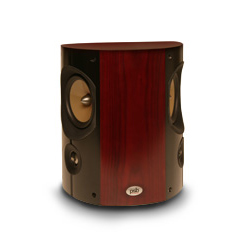
The tweeters have titanium domes and have ferrofluid cooling. The mids are polypropylene cones with rubber surrounds and aluminum phase plugs. All drivers are mounted within rubbery “cones” or “lenses”. This same material encloses the outlet of the ports and the input cups. It also shows up as a ridge along the base of the Imagine B’s since they would not stand up on their own without it. All in all, my impression of these speakers was that they are lovingly designed and very well constructed. This goes for the cabinets, the drivers, the crossovers, the whole package, really.
In Use
Some evidence of this system’s surround prowess was as follows: the ambience of the chapel during the opening sermon in Doubt was very well represented although the venue sounded a tad smaller than anticipated. In this same film, the many environmental sounds within the sparse mix were specifically rendered and were appropriately delicate or brash as intended by the filmmaker. The thundering herd in the stampede scene from Australia was also a surround highlight for this speaker system. Just as in Doubt, the environmental sounds were very well represented in space. The same could be said for my impression of the Blu-ray of The Curious Case of Benjamin Button.
The Imagine speakers were smooth operators. This was a very persistent observation of mine throughout the review period. I did at times feel that the sound was a little saccharin sweet, bordering on brittle as I heard at times on the SACD of Junior Brown’s “Down Home Chrome”. But that was an isolated observation. My lasting impression of the Imagine speakers was that they are smooth and articulate. Speech intelligibility was also very good, although I felt that the leading edges on voices were more natural when listening to SACD’s versus Blu-ray discs.
These speakers tended to sound bigger than their size would suggest. This tendency was most evident during the hyperactive soundtrack in Taken. The sound here was very impactful and articulate. I also relished in the clear and real sound of the cymbals in the yacht sequence. The treble and midrange shone when reproducing the more natural-sounding gunshots in the International.

The Imagine speakers were really in their element with music reproduction and I would like to offer further comment on the Imagines’ musical performance on SACD. The strummed strings were very delicate on The Bridge Washed Out (Track 4) of Junior Brown’s “Down Home Chrome”. Junior’s voice was nowhere near as chesty as I get with my reference system. On Hill Country Hot Rod (Track 5), the Imagines preserved the tempo nicely on this foot-tapper. The guitar, snare and cymbals all had a very live vibe to them. On Track 6, Jimmy Jones, the Imagines portrayed excellent dynamic contrasts.
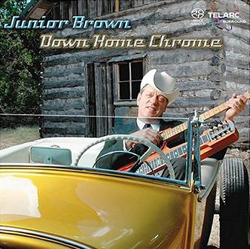
On track 12, Natural Woman, on the SACD of Carole’s “Tapestry”, the piano was reproduced remarkably well. I enjoyed the full emotional impact of this stellar work. This is one disc that I have had difficulty enjoying on my reference Definitive Technology speakers because the mix is tilted-up and it is typically too bright through the Def Techs for my tastes. The sound was still bright through the Imagines, but the Imagines’ smoother treble response made this disc listenable and enjoyable. The sound of the Imagines did start to sound hard at higher output levels, but I was unclear if this was due to limitations with the speakers or with the NAD T747 receiver.
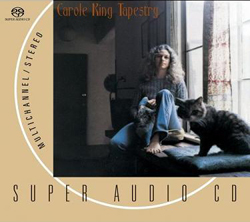
Specifications : PSB SubSeries 6i Subwoofer
- Design: Bass Reflex (Ported)
- Driver: One 12″ Polypropylene Woofer, 2″ Voice-Coil, 53 oz Magnet
- MFR: 29 Hz -150 Hz ± 3 dB
- Power: 225 Watts RMS
- Controls: Volume, Crossover, Phase (0°/180°), Crossover Bypass, and Master Power
- Dimensions: 20.8″ H x 16.4″ W x 21.3″ D
- Weight: 41 Pounds
- MSRP: $749 USA
- PSB Speakers
Introduction
The PSB Subseries 6i subwoofer is a very unassuming-looking product, albeit a little on the large size by today’s standards. It has a single 12″ driver in a ported enclosure. There are two ports that exit at the bottom front of the cabinet. The volume and crossover controls are mounted along the bottom of the front part of the cabinet as well. This arrangement allows the 6i to be mounted inside a cabinet.
The 6i is powered by a 225 Watt (continuous) BASH Class H Discrete MOSFET amp. This amp will accept single-ended line level inputs or high level inputs from a power amp. There is a 0° and 180° phase toggle and an on-standby/off toggle on the rear. The sub comes with decent, adjustable floor spikes.
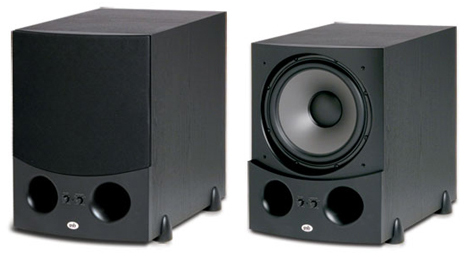
All in all, the 6i represents fairly pedestrian styling and design, but its performance is quite sophisticated. The driver in the 6i is apparently very rigid and the cabinet loading provides a well-dampened (tight) subwoofer system.
In Use
This sub was something of an enigma for me. It didn’t look very great. It has a plasticky front panel, ports and feet. Its black ash vinyl also contributed to its monolithic aesthetic. But when you turn it on and reflect back on its modest price, then your concerns over its looks will soon melt away. It was a real nice performer. Take, for example, the score on the Blu-ray of the Transporter. This sub reproduced the bass line of this music with surprising nimbleness and pitch definition. It also played loud enough to provide a very convincing performance on action films.

Like in the stampede scene in Australia where the Subseries 6i produced fine bass weight as the herd thundered through my theater. Later in this film, during the attack scene, the bass drive from this sub tickled my innards: pretty impressive considering the power rating of this sub along with the larger size of my theater space. There was surprising bass weight in many of the action movies I enjoyed while auditioning the Subseries 6i.
The Subseries 6i helped preserve the rhythm and tempo in music listening. It didn’t have the tightest bass I have ever heard. In comparison to my Hsu Research sub, however, the 6i sacrificed a certain amount of bass extension, but made up for it with improved timing, pace and it even bested my Hsu sub in the pitch definition department.
I was very impressed with this sub’s performance, especially at only $750. I just wish PSB would produce a version with a little nicer finish. If your priorities are to get great sound at a low price while not being overly concerned by the looks of your sub, then you owe it to yourself to audition the PSB Subseries 6i.
Conclusions
This system is a very classy collection of well conceived and executed products that will give you a little taste of the high end at a real-world price point. The stars of the show are the speakers and the Blu-ray player. The speakers offer up a very smooth, articulate sound with excellent imaging and surround envelopment. The subwoofer is a special treat, offering coherent reproduction of the bass registers. The Blu-ray player loads fast and plays discs without glitches. It outputs a picture with gobs and gobs of natural-looking detail and colors that are subjectively spot on.
The receiver holds up its end, and produces a clean sound with nuance and delicacy. It generally plays surprisingly loud without strain. It can reach the limit of its output capability on overtly rowdy action scenes and I would recommend it for rooms of up to about 3,000 cubic feet. The only knock on this receiver is that it doesn’t have the great flexibility you get with more mainstream offerings.
This system is a strong recommendation for small to mid size theaters. If you have a big room, then I suggest you move up to one of NAD’s more powerful receivers… the speakers and sub can surely handle the extra power.
Join us at the CAVE for further discussions about this and other Really Affordable Systems.
Pluses:
- Remarkable surround envelopment
- Smooth, articulate sound
- Excellent video performance with film-based Blu-ray discs
- Quick load times and responsive remote
- Surprising subwoofer performance
- Simple control interface
- RoHS Compliance
Minuses:
- No manual EQ capability
- No video pass-through
Overall System Rating:




